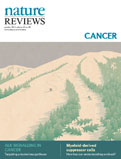|
Advertisement | |||||||||||||||||||||||||||||||||||||||||
| |||||||||||||||||||||||||||||||||||||||||
| TABLE OF CONTENTS | |||||||||||||||||||||||||||||||||||||||||
| October 2013 Volume 13 Number 10 | Advertisement | ||||||||||||||||||||||||||||||||||||||||
| In this issue
|
| |||||||||||||||||||||||||||||||||||||||
| |||||||||||||||||||||||||||||||||||||||||
 | |||||||||||||||||||||||||||||||||||||||||
| Advertisement | |||||||||||||||||||||||||||||||||||||||||
| |||||||||||||||||||||||||||||||||||||||||
| Advertisement | |||||||||||||||||||||||||||||||||||||||||
| |||||||||||||||||||||||||||||||||||||||||
| |||||||||||||||||||||||||||||||||||||||||
| Advertisement | |||||||||||||||||||||||||||||||||||||||||
| |||||||||||||||||||||||||||||||||||||||||
| REVIEWS | Top | ||||||||||||||||||||||||||||||||||||||||
| Mechanistic insight into ALK receptor tyrosine kinase in human cancer biology Bengt Hallberg & Ruth H. Palmer p685 | doi:10.1038/nrc3580 Anaplastic lymphoma kinase (ALK) is commonly altered — through mutation, overexpression or translocation — in many types of cancer, but the role of ALK signalling in mammalian cells and tumours remains enigmatic. What can we learn from model systems? And what progress has been made in targeting this receptor tyrosine kinase? Abstract | Full Text | PDF | |||||||||||||||||||||||||||||||||||||||||
| Krüppel-like factors in cancer Marie-Pier Tetreault, Yizeng Yang & Jonathan P. Katz p701 | doi:10.1038/nrc3582 Krüppel-like factor (KLF) transcriptional regulators have diverse functions in many cancer-relevant processes. This Review discusses the context-dependent roles for KLFs in different cancers and identifies key questions for the field. Abstract | Full Text | PDF | Supplementary information | |||||||||||||||||||||||||||||||||||||||||
| Cancer drug resistance: an evolving paradigm Caitriona Holohan, Sandra Van Schaeybroeck, Daniel B. Longley & Patrick G. Johnston p714 | doi:10.1038/nrc3599 This Review discusses mechanisms of resistance to 'classical' cytotoxic chemotherapeutics and molecularly targeted therapies, which share many features. It is hoped that an improved understanding of the molecular basis of resistance will lead to rational drug combinations and predictive biomarkers. Abstract | Full Text | PDF | |||||||||||||||||||||||||||||||||||||||||
| PERSPECTIVES | Top | ||||||||||||||||||||||||||||||||||||||||
| OPINION Unravelling cancer stem cell potential Benjamin Beck & Cédric Blanpain p727 | doi:10.1038/nrc3597 What can we learn about cancer stem cells and tumour tissue hierarchy from what we know about stem cells? Read this Opinion article to find out how our knowledge of normal stem cells applies to cancer stem cells in solid tumours. Abstract | Full Text | PDF | |||||||||||||||||||||||||||||||||||||||||
| TIMELINE History of myeloid-derived suppressor cells James E. Talmadge & Dmitry I. Gabrilovich p739 | doi:10.1038/nrc3581 Myeloid-derived suppressor cells (MDSCs) remain steeped in mystery and controversy — how do we identify them? How are they recruited to the tumour microenvironment? How do they suppress antitumour immunity? This Timeline article discusses the discovery of MDSCs and what we know now — and need to know in the future — about the role of MDSCs in cancer biology. Abstract | Full Text | PDF | |||||||||||||||||||||||||||||||||||||||||
| Corrigendum: The DREAM complex: master coordinator of cell cycle-dependent gene expression Subhashini Sadasivam & James A. DeCaprio p752 | doi:10.1038/nrc3598 Full Text | PDF | |||||||||||||||||||||||||||||||||||||||||
| Advertisement | |||||||||||||||||||||||||||||||||||||||||
| |||||||||||||||||||||||||||||||||||||||||
| |||||||||||||||||||||||||||||||||||||||||
| *2012 Journal Citation Report (Thomson Reuters, 2013) |
You have been sent this Table of Contents Alert because you have opted in to receive it. You can change or discontinue your e-mail alerts at any time, by modifying your preferences on your nature.com account at: www.nature.com/myaccount For further technical assistance, please contact our registration department For print subscription enquiries, please contact our subscription department For other enquiries, please contact our feedback department Nature Publishing Group | 75 Varick Street, 9th Floor | New York | NY 10013-1917 | USA Nature Publishing Group's worldwide offices: Macmillan Publishers Limited is a company incorporated in England and Wales under company number 785998 and whose registered office is located at Brunel Road, Houndmills, Basingstoke, Hampshire RG21 6XS. © 2013 Nature Publishing Group, a division of Macmillan Publishers Limited. All Rights Reserved. |
 |









No comments:
Post a Comment